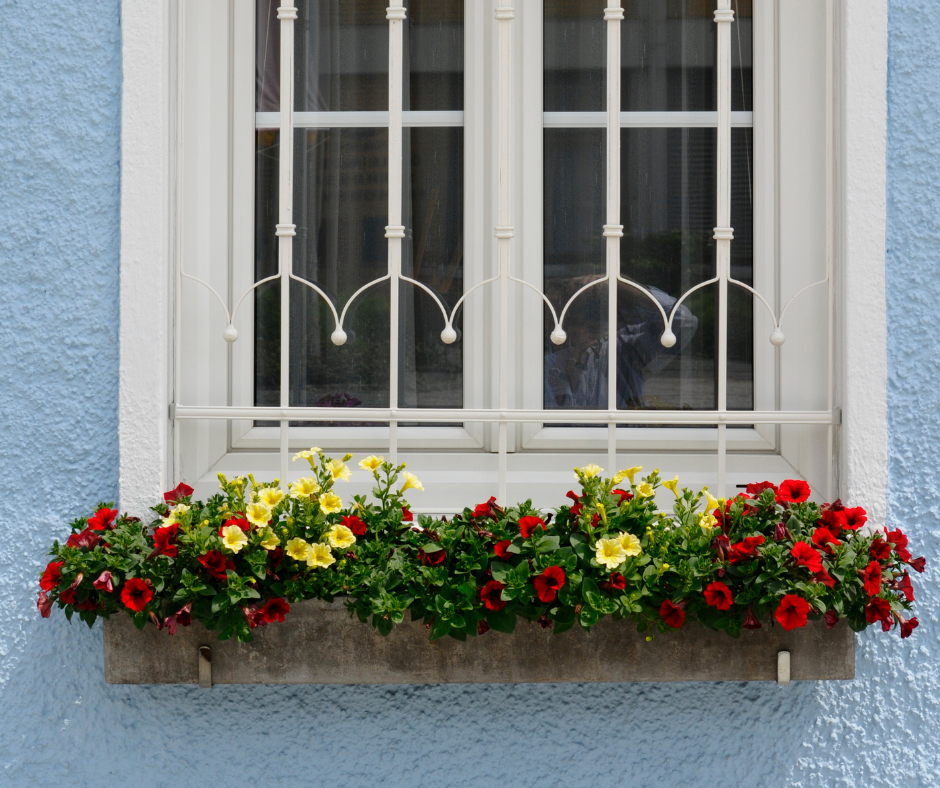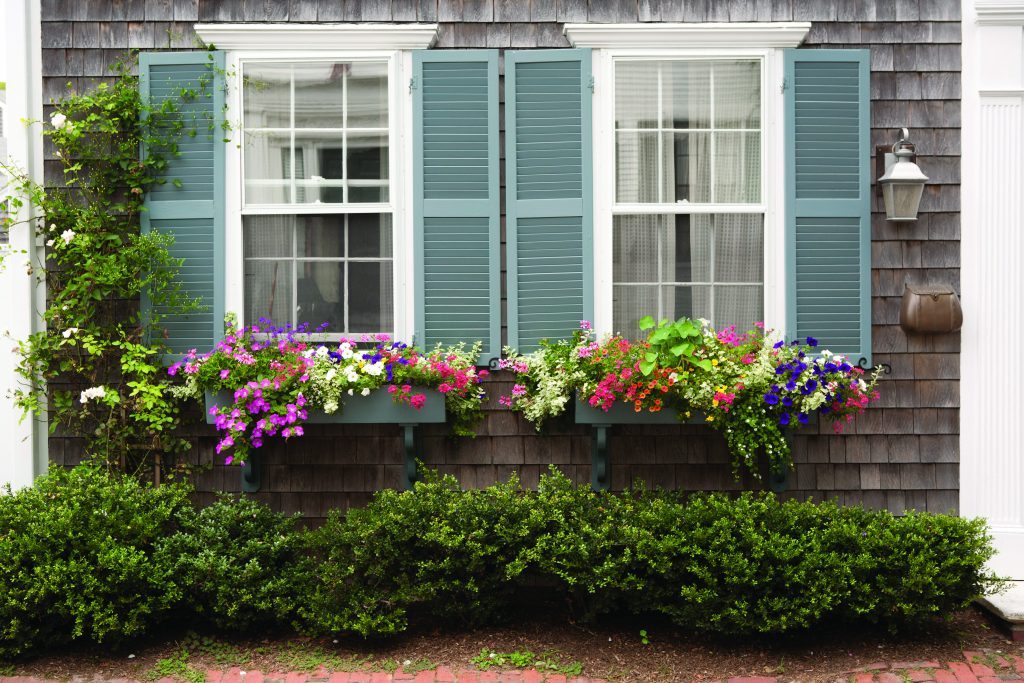
Are you looking to add a little curb appeal to your home? Window box planters can be the perfect option to add some charm to the look of your abode and refresh the views outside your windows. Whether you’re looking for a style update or just some herbs right outside your kitchen window, we’ve got you covered.
Choosing Your Window Box
First things first—you have to decide what style of window box works for you and where you want to put them.

Location of Your Window Box
Before you can pick the perfect window box planters, you’ve got to figure out where you want to mount them. Aesthetics are a large part of this decision, but people often forget functional considerations when choosing a location for their window box. Sure, it might look magical to have an abundance of flowers trailing out of a third floor attic window box—but how are you going to water and prune them?
We always recommend that homeowners think about how they’re going to plant and water their window boxes before grabbing the drill and mounting their brackets. If you’re planning on doing all of your watering the old fashioned way with a watering can, it’ll be much easier to care for an easily-accessible first floor window box. And trust us—it’s much better to plant them from the outside instead of having to do it from the inside over your nice carpet.
Installing a drip irrigation system will offer a little more freedom in placement, allowing you to pipe the water directly to a difficult to access box in a one-and-done weekend project. Do remember to check on all window boxes regularly—even the irrigated ones—to see if they need extra water. Boxes that face south and west receive more direct sunlight and will dry out faster than boxes on the opposite side of the house, and the shallow soil of window boxes makes them prone to drying out in hot weather.
Finally, don’t forget that planters require regular maintenance. Seasonal annuals planted in the spring will need to be rotated out for summer and fall plants. Many flowering plants require regular deadheading to bloom their best. Even the most low maintenance window planter box will benefit from periodic pruning and tidying to remove detritus and keep things looking tidy.

Style of Your Window Box
Choosing the style of your window boxes is the fun part! You’ve got a wealth of options from sleek, minimalist stainless steel planters for a modern home to budget-friendly recycled pallet boxes for a rustic cottage feel. Before you go wild at the garden store, we recommend thinking about three factors: size, durability, and simplicity.
One of the most common mistakes our designers see in DIY window boxes is choosing ones too small for their windows. This is a category where we actually think that bigger is often better.
If you’re going to go through the trouble of installing a wall-mounted planter, it should be large enough to fit a bounty of plants and make a real stylistic impact on your home. Additionally, smaller boxes have less room for soil, meaning they’ll dry out faster and require more frequent watering—which makes more work for you.
Durability is another factor to think about when it comes to the long term upkeep of your window boxes. Wooden window boxes can have a traditional or rustic appeal, but they will rot over time from being routinely dampened. We recommend using a more long-lasting material.
Plastic window boxes are lightweight and water resistant. If you like the look of wood, a PVC composite can give you the same look with much better durability. Metal is also an attractive option, but we recommend a rust-free material like powder-coated metal or copper window boxes (which will also gain a beautiful natural patina over time).
Finally, when in doubt, keep things simple. While there’s a whole range of window boxes out there that are show stoppers in their own right, our philosophy has always been that the focus should be on the plants in the box, not the box itself.
One trick to make sure that your new window boxes blend in with your home’s style is to match the planter color to the frames of the windows. If they’ll be under a white window, use a white box—and that way your window boxes will look like they were always meant to be there. Perfect.



Choosing Plants for Your Window Box
When it comes to planting your new window boxes, you’ve got a lot of options. We’re here to help you narrow down the mega-list into something manageable that will give you fool-proof, beautiful boxes.
The first thing to consider is the area where you’re going to be planting. Is it on the shady side of your house? Sun-loving plants are out. Do you live in a desert climate? Look for drought-tolerant plants. Do you get lots of rain? Choose water-loving plants—and definitely get window boxes with drainage holes.
You should also think about the purpose of the plants that you’re selecting. If you’re looking for a splash of color, fill your window flower boxes with bountiful blooms. If your exterior feels lifeless, use trailing and vining plants to add lush, vibrant greenery.
Don’t forget that you can also plant herbs and vegetables in window boxes—they don’t just have to be ornamental! It’s a natural choice to plant some thyme or mint outside your kitchen window, and even cherry tomatoes and leafy greens can be window box candidates.
And of course, you can’t forget the aesthetics of your window box. Everyone wants a beautiful planter, and we’ve got advice to help you create just that. Picking a plant palette to work with will keep things simple—a selection of 2-5 plants that go together and bring dimension to your window box.
An easy formula to follow is to choose a plant with height, a low-growing filler plant, and a trailing or climbing plant to pull the eyes vertically. Forget about blah window box planters with just one flower—you’re going to have the most interesting window box on the block.
With all that in mind, it’s time to pick the plants that speak to you. Here are a few of our favorite window box plant selections to help jumpstart your creative process:



Plants for Sunny Window Boxes
- Marigold
- Miniature rose
- Daffodil
- Lily
- Lavender
- Rosemary
- Thyme
- Kale
- Tomato
- Strawberry
- Nasturtium
- Petunia
- Honeysuckle
- Jasmine
Plants for Shady Window Boxes
- English daisy
- Pansy
- Snowdrop
- Crocus
- Coleus
- Impatiens
- Lemon balm
- Peppermint
- Parsley
- Oregano
- Spinach
- English ivy
- Clematis
- Trumpet Vine


With all this information under your belt, you’re ready to start planning your perfect window box! Take a walk around your neighborhood and check out other window boxes for inspiration—and to see what grows well in your area. Log all your design inspiration in a Pinterest board or a good ol’ fashioned notebook, and soon you’ll be hitting your local nursery with a full planting plan in hand. Most importantly, planting a window box should be fun, so get creative and enjoy! And remember, if you partner with Tilly we can add window boxes to our 3D images (a design package add on) if you want to see what window boxes could look like on your home!
Read more about: Gardening Tips